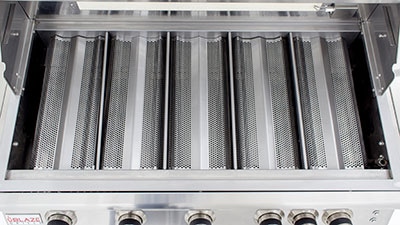Why go with a Gas Grill?
The age-old grilling debate pits gas against charcoal, but the recent popularity of pellet grills has thrown another competitor into the mix. So what sets gas apart from the other fuels? For starters, gas grills provide instant heat as opposed to pellets or charcoal that take longer to ignite and reach desired temperatures. Cleanup is also quicker and less messy — there’s no ash to dispose of, and removable drip trays make grease management a breeze.
Though pellet grills get a lot of love for ease of use, gas grills offer similar simplicity and convenience. They don’t require you to reload pellets, and when compared with charcoal grills, turning a burner knob is far easier than stoking a fire and adjusting vents. Perhaps the best trait of gas grills is their ability to maintain stable levels of high heat, which allow you to quickly crank out food for the whole family.
Benefits of Gas Grills
- High Heat: Many gas grills can top 700°F, and some are even capable of reaching over 1,000 degrees Fahrenheit with no trouble at all.
- Instant Ignition: Simply push a button or turn a knob to fire up the grill, which generally has a secondary ignition method should the primary igniter fail.
- Fast Preheat: Gas grills reach desired temperature almost instantly after they’re lit, and the cooking grates preheat quickly to guarantee gorgeous sear marks.
- Temperature Control: Not only do these grills excel at maintaining almost any heat level, but they’re also designed to spread it evenly across your cooking surface.
- Versatility: High heat isn’t all gas grills are good at. Indirect grilling is possible on models with multiple burners, and some can pull off low-and-slow smoking.
- Easy to Use: Gas grills require virtually no guesswork and have independently controlled burners that can be turned on or off in seconds.
- Customizable: Choose from different styles, configurations, burners, and a wide variety of accessories that makes gas grills easy to personalize.
- Stylish: With mirror-polished stainless steel, LED light displays, and matching outdoor kitchen equipment, gas grills are in a category all their own.
How do Gas Grills Work?
Gas grills are fueled by either propane stored in tanks or natural gas that’s piped into the home by a utility company. Keep in mind that only certified professionals should ever work on gas lines, especially when converting a grill from one fuel to another (which is difficult to perform and may even void your warranty). The differences between natural gas grills and propane gas grills are minor, but in each fuel type gas is placed under a specific pressure and sent to the burners for combustion. Once combustion of fuel has produced heat for grilling, that heat is spread throughout the firebox and grill head to cook your food. Gas grills manipulate heat using 3 components — burners, flame tamers, and cooking grates.
Gas Grill Burners

Tube burners, which are essentially steel pipes with holes drilled down the sides or top, come in either a straight or U-shaped configuration. Die-cast stainless steel or cast aluminum burners, meanwhile, are generally in an H-shaped or “bar” arrangement. Cast aluminum is the most desirable material because it never rusts, but it’s still important to clean your gas grill burners no matter which type you own. Burners are positioned so you can take advantage of dual-zone grilling, a technique that’s easier in grills with heat zone separators that divide the firebox into sections containing individual burners.
Gas Grill Flame Tamers

These components usually sit between the burners and cooking grates, evenly dispersing heat across the grilling surface and throughout the grill head so you don’t have to deal with pesky hot or cold spots. In addition to evenly radiating heat, flame tamers catch grease drippings that can clog the gas ports of the burners below. Those drippings are then vaporized and sent back toward your food in the form of flavorful smoke. Flame tamers are generally made from some type of steel, stainless steel, or aluminum, though ceramic briquette units are gaining popularity because of their effectiveness.
Gas Grill Cooking Grates

This is where your food sits within the grill. Don’t overlook the material used in the construction of the cooking grates — their composition goes a long way toward transferring heat to your food and creating beautiful sear marks. Grill grates thicker than 8 millimeters are ideal for bold sear marks, and you’ll get even better results if they’re made of cast iron, which is excellent at absorbing and radiating heat. Thick or cast stainless steel, however, may last longer than cast iron. When in doubt, you can’t go wrong with sturdy cooking grates made from commercial-grade, 304 stainless steel.
